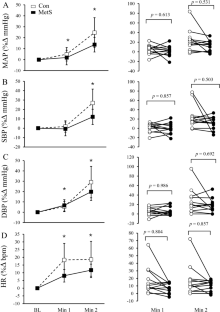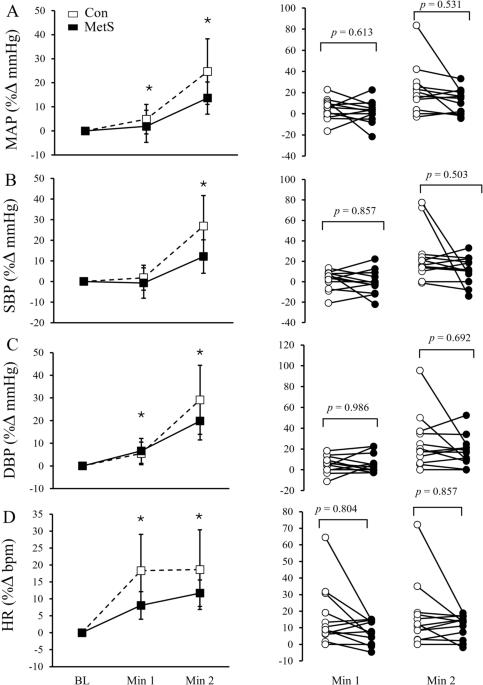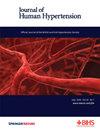代谢综合征患者对冷加压试验的血流动力学反应:一项多种族成人样本的病例对照研究。
IF 3.4
4区 医学
Q2 PERIPHERAL VASCULAR DISEASE
引用次数: 0
摘要
以前的研究表明,代谢综合征患者的运动加压和代谢反射反应明显夸大,但这些夸大反应是否会延伸到冷加压试验(CPT)中还不清楚。本研究测试了一个假设,即与之前报道的运动时的夸张反应相反,与匹配的对照组相比,代谢综合征患者的 CPT 反应不会明显夸张。11 名 MetS 患者和 11 名年龄、种族、性别和民族相匹配的对照组参与者完成了心脏代谢预检和 CPT。每次 CPT 都要求参与者将手浸入冰水中两分钟,同时连续测量逐次跳动的血压、心率(HR)和腿部血流量(LBF)。腿部血管传导率(LVC)的计算方法是 LBF 除以平均动脉压(MAP)。使用重复测量方差分析比较了不同时间段(BL vs. CPT 第 1 和第 2 分钟)和不同组别(MetS vs. 对照组)MAP、收缩压 (SBP)、舒张压 (DBP)、心率 (HR)、LBF 和 LVC 的百分比变化。不出所料,MAP(f = 32.11,p本文章由计算机程序翻译,如有差异,请以英文原文为准。


Hemodynamic responses to the cold pressor test in individuals with metabolic syndrome: a case-control study in a multiracial sample of adults
Previous research shows that exercise pressor and metaboreflex responses are significantly exaggerated in individuals with metabolic syndrome, but it is unclear if these exaggerated responses extend to the cold pressor test (CPT). This study tested the hypothesis that, contrary to previously reported exaggerated responses during exercise, CPT responses would not be significantly exaggerated in individuals with MetS compared to matched controls. Eleven individuals with MetS and eleven control participants matched by age, race, sex, and ethnicity completed a cardiometabolic prescreening and a CPT. Each CPT required participants to immerse their hand in ice water for two minutes while beat-by-beat blood pressure, heart rate (HR), and leg blood flow (LBF) were continuously measured. Leg vascular conductance (LVC) was calculated as LBF divided by mean arterial pressure (MAP). The precent changes in MAP, systolic blood pressure (SBP), diastolic blood pressure (DBP), HR, LBF, and LVC were compared across time (BL vs. Minutes 1 and 2 of CPT) and between groups (MetS vs. Control) using repeated measures analyses of variance. As expected, MAP (f = 32.11, p < 0.001), SBP (f = 23.18, p < 0.001), DBP (f = 40.39, p < 0.001), and HR (f = 31.81, p < 0.001) increased during the CPT, and LBF (f = 4.75, p = 0.014) and LVC (f = 13.88, p < 0.001) decreased. However, no significant main effects of group or group by time interactions were observed (f ≤ 0.391, p ≥ 0.539). These findings indicate that the hemodynamic responses to the CPT are not significantly exaggerated in MetS, and therefore, previous reports of exaggerated exercise pressor and metaboreflex responses in MetS cannot be attributed to generalized sympathetic overexcitability.
求助全文
通过发布文献求助,成功后即可免费获取论文全文。
去求助
来源期刊

Journal of Human Hypertension
医学-外周血管病
CiteScore
5.20
自引率
3.70%
发文量
126
审稿时长
6-12 weeks
期刊介绍:
Journal of Human Hypertension is published monthly and is of interest to health care professionals who deal with hypertension (specialists, internists, primary care physicians) and public health workers. We believe that our patients benefit from robust scientific data that are based on well conducted clinical trials. We also believe that basic sciences are the foundations on which we build our knowledge of clinical conditions and their management. Towards this end, although we are primarily a clinical based journal, we also welcome suitable basic sciences studies that promote our understanding of human hypertension.
The journal aims to perform the dual role of increasing knowledge in the field of high blood pressure as well as improving the standard of care of patients. The editors will consider for publication all suitable papers dealing directly or indirectly with clinical aspects of hypertension, including but not limited to epidemiology, pathophysiology, therapeutics and basic sciences involving human subjects or tissues. We also consider papers from all specialties such as ophthalmology, cardiology, nephrology, obstetrics and stroke medicine that deal with the various aspects of hypertension and its complications.
 求助内容:
求助内容: 应助结果提醒方式:
应助结果提醒方式:


